Integration of Coke and CNMs with Bitumen: Synthesis, Methods, and Characterization
Abstract
1. Introduction
2. Materials and Methods
3. Bitumen Modification
3.1. Coke and Coke-Derived Materials
3.2. Mechanism of Coke–Bitumen Interfacial Bonding
3.3. Coke as a Modifier for Bitumen
3.4. Carbon Nanomaterials (CNMs)
| No. | Synthesis Method | Raw Materials | Synthesis Temperature (°C) | Proposed Production Materials | Scale Sensitivity | Reference |
|---|---|---|---|---|---|---|
| 1 | Arc discharge | Graphite electrodes and inert gas (He/Ar) | 4500–5500 | SWCNTs, MWCNTs, and fullerenes | Lab to medium | [72] |
| 2 | Laser ablation | Graphite target, laser beam, and metal catalyst | 3000–3500 | High-purity SWCNTs | Lab-scale only | [69] |
| 3 | Chemical vapor deposition | Hydrocarbons (e.g., CH4, C2H2) and metal catalyst (Fe, Co, Ni) | 600–1200 | SWCNTs, MWCNTs, and graphene | Industrial scale | [68] |
| 4 | Pyrolysis | Organic precursors (e.g., sugars, polymers) | 400–900 | Carbon dots, amorphous carbon, and carbon black | Medium scale | [68] |
| 5 | Hydrothermal/Solvothermal | Biomass, glucose, citric acid, and organic solvents | 150–300 (autoclave) | Carbon quantum dots and graphene quantum dots | Lab scale | [68] |
| 6 | Template-assisted method | Polymer/oxide template + carbon source | 500–800 | 3D graphene foams and CNT forests | Lab to small | [71] |
| 7 | Ball milling | Graphite flakes | Room temp | Amorphous carbon and graphene nanoplatelets | Industrial scale | [69] |
3.5. CNMs as a Modifier for Bitumen
4. Limitations and Future Prospects
5. Conclusions
Author Contributions
Funding
Data Availability Statement
Conflicts of Interest
References
- Pipintakos, G.; Sreeram, A.; Mirwald, J.; Bhasin, A. Engineering bitumen for future asphalt pavements: A review of chemistry, structure and rheology. Mater. Des. 2024, 244, 113157. [Google Scholar] [CrossRef]
- Gunka, V.; Astakhova, O.; Hrynchuk, Y.; Sidun, I.; Reutskyy, V.; Mirchuk, I.; Poliak, O. A review of road bitumen modification methods. Part 1–physical modification. Chem. Chem. Technol. 2024, 18, 295–304. [Google Scholar] [CrossRef]
- Cabral, R.L.B.; Galvão, E.R.V.P.; Fechine, P.B.A.; Galvão, F.M.F.; do Nascimento, J.H.O. A minireview on the utilization of petroleum coke as a precursor for carbon-based nanomaterials (CNMs): Perspectives and potential applications. RSC Adv. 2024, 14, 19953–19968. [Google Scholar] [CrossRef]
- Halali, M.A.; Ghotbi, C.; Tahmasbi, K.; Ghazanfari, M.H. The role of carbon nanotubes in improving thermal stability of polymeric fluids: Experimental and modeling. Ind. Eng. Chem. Res. 2016, 55, 7514–7534. [Google Scholar] [CrossRef]
- Korniejenko, K.; Nykiel, M.; Choinska, M.; Jexembayeva, A.; Konkanov, M.; Aruova, L. An overview of micro-and nano-dispersion additives for asphalt and bitumen for road construction. Buildings 2023, 13, 2948. [Google Scholar] [CrossRef]
- Gorman, J.L.; Crawford, R.J.; Harding, I.H. Bitumen emulsions in road construction-A review. Road Trans. Res. 2004, 13, 25. [Google Scholar]
- Syzdykova, A.; Zhakyp, A.; Tulebekova, A. Features of using modified bitumen in road construction. Technobius 2021, 1, 0007. [Google Scholar] [CrossRef]
- Shakhmov, Z.; Zhumagulova, A.; Kosparmakova, S.; Kozhahmet, A.; Kabdrashit, J. Properties of modified bitumen in road construction. Technobius 2023, 3, 0040. [Google Scholar] [CrossRef]
- Adem, A.A.; Panjiar, H.; Daniel, B.S.S. The effect of nanocarbon inclusion on mechanical, tribological, and thermal properties of phenolic resin-based composites: An overview. Eng. Rep. 2024, 6, e12861. [Google Scholar] [CrossRef]
- Nemade, S.N.; Thorat, P.V. Utilization of polymer waste for modification of bitumen in road construction. Sci. Rev. Chem. Comm. 2013, 2, 198–213. [Google Scholar]
- Appiah, J.K.; Berko-Boateng, V.N.; Tagbor, T.A. Use of waste plastic materials for road construction in Ghana. Case Stud. Constr. Mater. 2017, 6, 1–7. [Google Scholar] [CrossRef]
- Baldo, N.; Rondinella, F.; Daneluz, F.; Pasetto, M. Foamed bitumen mixtures for road construction made with 100% waste materials: A laboratory study. Sustainability 2022, 14, 6056. [Google Scholar] [CrossRef]
- Sabadra, V. Use of polymer modified bitumen in road construction. Int. Res. J. Eng. Technol. 2017, 4, 799–801. [Google Scholar]
- Yu, J.; Vaidya, M.; Su, G.; Adhikari, S.; Korolev, E.; Shekhovtsova, S. Experimental study of soda lignin powder as an asphalt modifier for a sustainable pavement material. Constr. Build. Mater. 2021, 298, 123884. [Google Scholar] [CrossRef]
- Chauhan, S.K.; Sharma, S.; Shukla, A.; Gangopadhyay, S. Recent trends of the emission characteristics from the road construction industry. Envir. Sci. Poll. Res. 2010, 17, 1493–1501. [Google Scholar] [CrossRef]
- Hashami, M.; Ongarbayev, Y.; Abdikhan, D.; Akkazin, E.; Nessipbayeva, N. Ozonation of bitumen: Characteristics, characterization, and applications. Processes 2025, 13, 708. [Google Scholar] [CrossRef]
- Caputo, P.; Oliviero Rossi, C.; Calandra, P.; Policastro, D.; Giorno, E.; Godbert, N.; Aiello, I. Improving bitumen properties with chitosan: A sustainable approach to road construction. Molecules 2025, 30, 1170. [Google Scholar] [CrossRef]
- Al-Sabaeei, A.; Yussof, N.I.M.; Napiah, M.; Sutanto, M. A review of using natural rubber in the modification of bitumen and asphalt mixtures used for road construction. J. Teknol. 2019, 81, 81–88. [Google Scholar] [CrossRef]
- Vargas, C.A.; El Hanandeh, A. Eco-friendly asphalt mixtures: Examining the performance of PE pyrolytic wax-modified bitumen for road construction. Clean Technol. Envir. Policy 2024, 26, 447–465. [Google Scholar] [CrossRef]
- Jeffry, S.N.A.; Putra Jaya, R.; Abdul Hassan, N.; Yaacob, H.; Mahmud, M.Z.H.; Al-Saffar, Z.H. The influence of nano-carbon from coconut shell ash as modifier on the properties of bitumen. Road Mater. Pav. Des. 2022, 23, 770–786. [Google Scholar] [CrossRef]
- Hassan, N.A.; Ruzi, N.A.; Shukry, N.A.M.; Jaya, R.P.; Hainin, M.R.; Kamaruddin, N.H.M.; Abdullah, M.E. Physical properties of bitumen containing diatomite and waste engine oil. Malays. J. Fund. Appl. Sci. 2019, 15, 528–531. [Google Scholar] [CrossRef]
- Erdenetsogt, B.E.; Khashbaatar, Z.; Dash, I.; Tsog, B. Feasibility investigation of bitumen properties by blending of coal tar pitch. Adv. Chem. Eng. Sci. 2023, 3, 93–104. [Google Scholar] [CrossRef]
- Kasraie, M.; Krieg, A.S.; Abbott, A.C.; Gawde, A.; Eisele, T.C.; King, J.A.; Abadi, P.P.S.S. Carbon nanotube as a conductive rheological modifier for carbon fiber-reinforced epoxy 3D printing inks. Compos. B Eng. 2024, 282, 111583. [Google Scholar] [CrossRef]
- Sengottuvelu, D.; Almashaqbeh, H.K.; Majdoub, M.; Pramanik, A.; Rushing, G.; Doyle, J.; Al-Ostaz, A. Improved oxidation of graphite and graphene nanoplatelets: Application to the modification of asphalt binder. ACS Appl. Nano Mater. 2024, 7, 3939–3949. [Google Scholar] [CrossRef]
- Niu, W.; Li, Y.; Li, Q.; Wang, J.; Wang, G.; Zuo, H.; Xue, Q. Physical and chemical properties of metallurgical coke and its evolution in the blast furnace ironmaking process. Fuel 2024, 366, 131277. [Google Scholar] [CrossRef]
- Tiwari, H.P.; Sharma, R.; Kumar, R.; Mishra, P.; Roy, A.; Haldar, S.K. A review of coke making by-products. Coke Chem. 2014, 57, 477–484. [Google Scholar] [CrossRef]
- Guo, P.; Lei, R.; Liu, W.; Liu, J.; Hou, C.; Sun, Y.; Su, W. Activated coke for synergistic removal of multiple pollutants from sintering flue gas: A review. Fuel 2025, 381, 133506. [Google Scholar] [CrossRef]
- Tang, Q.; Li, Q.; Zhou, H.; Leng, E.; Wang, B.; Gao, S.; Deng, Y. Performance regulation of biomass-derived coke for metallurgical applications based on the fractional utilization of biomass pyrolysis oil. Energy 2025, 316, 134631. [Google Scholar] [CrossRef]
- Moskalev, I.V.; Kiselkov, D.M.; Strelnikov, V.N.; Valtsifer, V.A.; Petrovykh, A.P.; Petrov, A.V.; Beilina, N.Y. Production of isotropic coke in industrial trials. Coke Chem. 2014, 57, 202–207. [Google Scholar] [CrossRef]
- Guarin, A.; Khan, A.; Butt, A.A.; Birgisson, B.; Kringos, N. An extensive laboratory investigation of the use of bio-oil modified bitumen in road construction. Constr. Build. Mater. 2016, 106, 133–139. [Google Scholar] [CrossRef]
- Vyas, S.N.; Patwardhan, S.R.; Vijayalakshmi, S.; Gangadhar, B. Synthesis of carbon molecular sieves by activation and coke deposition. Fuel 1993, 72, 551–555. [Google Scholar] [CrossRef]
- Gray, R.J.; Devanney, K.F. Coke carbon forms: Microscopic classification and industrial applications. Int. J. Coal Geol. 1986, 6, 277–297. [Google Scholar] [CrossRef]
- Wu, M.; Li, Z.; Huang, J.; Wang, Q.; Li, T.; Yang, S.; Jiang, Y. Non-isothermal kinetics of coke and iron ore melting reduction with variable activation energy model. Fuel 2024, 357, 129991. [Google Scholar] [CrossRef]
- Zheng, H.; Xu, R.; Zhang, J.; Daghagheleh, O.; Schenk, J.; Li, C.; Wang, W. A comprehensive review of characterization methods for metallurgical coke structures. Materials 2021, 15, 174. [Google Scholar] [CrossRef] [PubMed]
- Kapustin, V.M.; Glagoleva, V.F. Physicochemical aspects of petroleum coke formation. Petrol. Chem. 2016, 56, 1–9. [Google Scholar] [CrossRef]
- Sahoo, S.K.; Ray, S.S.; Singh, I.D. Structural characterization of coke on spent hydroprocessing catalysts used for processing of vacuum gas oils. Appl. Catal. A Gen. 2004, 278, 83–91. [Google Scholar] [CrossRef]
- Khani, Y.; Pyo, S.; Bahadoran, F.; Cho, K.; Jeong, K.E.; Park, Y.K. Synthesis of coke-resistant catalyst using NiAl2O4 support for hydrogen production via autothermal dry reforming of methane. Chem. Catal. Chem. 2025, 17, e202401015. [Google Scholar] [CrossRef]
- Donskoi, E.; Poliakov, A.; Mahoney, M.R.; Scholes, O. Novel optical image analysis coke characterisation and its application to study of the relationships between coke structure, coke strength and parent coal composition. Fuel 2017, 208, 281–295. [Google Scholar] [CrossRef]
- Ghosh, B.; Sahoo, B.K.; Chakraborty, B.; Manjhi, K.K.; Das, S.K.; Sahu, J.N.; Varma, A.K. Influence of coke structure on coke quality using image analysis method. Int. J. Coal Sci. Technol. 2018, 5, 473–485. [Google Scholar] [CrossRef]
- Benoy, S.M.; Hazarika, A.; Rajbongshi, A.; Bora, M.; Saikia, B.K. Hierarchical porous carbon derived from petroleum coke via one-step chemical activation for the fabrication of a supercapacitor and real time clock application. RSC Adv. 2024, 14, 21411–21424. [Google Scholar] [CrossRef]
- Pham-Ngoc, N.; Jamsaz, A.; Lee, Y.; Oh, E.S.; Shin, E.W. Homogeneous formation of a disordered NiAl2O4 structure in three-dimensional macroporous Ni/Al2O3 catalysts for dry reforming of methane and coke-resistant catalytic, behavior on its Ni-oxygen vacancy interface. Chem. Eng. J. 2025, 510, 161545. [Google Scholar] [CrossRef]
- Razzaq, R.; Li, C.; Zhang, S. Coke oven gas: Availability, properties, purification, and utilization in China. Fuel 2013, 113, 287–299. [Google Scholar] [CrossRef]
- Azari, K.; Alamdari, H.; Ziegler, D.; Fafard, M. Influence of coke particle characteristics on the compaction properties of carbon paste material. Powder Technol. 2014, 257, 132–140. [Google Scholar] [CrossRef]
- Gray, R.J. Some petrographic applications to coal, coke and carbons. Org. Geochem. 1991, 17, 535–555. [Google Scholar] [CrossRef]
- Li, Z.; Tie, W.; Huang, J.; Wang, Q.; Li, T.; Yang, S.; Zhang, S. Analysis of the differences in coke thermal properties testing. Fuel 2023, 354, 129359. [Google Scholar] [CrossRef]
- Fu, X.; Pang, Q.; Yang, X.; Zhan, W.; He, Z. Effect of high temperature on macroscopic properties and microstructure of metallurgical coke. Fuel 2024, 356, 129543. [Google Scholar] [CrossRef]
- Valecillos, J.; Iglesias-Vázquez, S.; Remiro, A.; Bilbao, J.; Gayubo, A.G. Formation and properties of carbon/coke as nanostructured materials and deactivating agent in the ethanol steam reforming over a catalyst derived from Ni-Al spinel. Fuel 2025, 385, 134082. [Google Scholar] [CrossRef]
- Wei, Y.; Dou, H.; Gao, J.; Zhang, Q.; He, T.; Mu, B.; Wang, A. An exploration of oil shale semi-coke recycling utilization: High temperature activation mechanism and cementitious material precursor preparation. J. Build. Eng. 2025, 104, 112288. [Google Scholar] [CrossRef]
- Miroshnichenko, D.; Shmeltser, K.; Kormer, M. Factors affecting the formation the carbon structure of coke and the method of stabilizing its physical and mechanical properties. C 2023, 9, 66. [Google Scholar] [CrossRef]
- Li, Y.; Zhao, X.; Qi, Y.; Zhu, H.; Appiah, J.; Yu, P.; Dou, J. Insight into the correlation between coke structure and coke thermal properties. J. Energy Inst. 2025, 119, 102002. [Google Scholar] [CrossRef]
- Nyathi, M.S.; Kruse, R.; Mastalerz, M.; Bish, D.L. Nature and origin of coke quality variation in heat-recovery coke making technology. Fuel 2016, 176, 11–19. [Google Scholar] [CrossRef]
- Babich, A.; Senk, D. Coke in the iron and steel industry. In New Trends in Coal Conversion; Suarez-Ruiz, I., Diez, M.A., Rubiera, F., Eds.; Woodhead Publishing: Cambridge, UK, 2019; pp. 367–404. [Google Scholar]
- Gray, M.R. Fundamentals of bitumen coking processes analogous to granulations: A critical review. Can. J. Chem. Eng. 2002, 80, 393–401. [Google Scholar] [CrossRef]
- Sarkar, A.; Kocaefe, D.; Kocaefe, Y.; Sarkar, D.; Bhattacharyay, D.; Morais, B.; Chabot, J. Coke–pitch interactions during anode preparation. Fuel 2014, 117, 598–607. [Google Scholar] [CrossRef]
- Ivkin, A.S.; Vasiliev, V.V.; Salamatova, E.V.; Povarov, V.G.; Maidanova, N.V.; Kalinin, M.V.; Strakhov, V.M. Adhesion of bitumen to minerals. Coke Chem. 2022, 65, 24–32. [Google Scholar] [CrossRef]
- Gao, Y.; Zhang, Y.; Yang, Y.; Zhang, J.; Gu, F. Molecular dynamics investigation of interfacial adhesion between oxidised bitumen and mineral surfaces. Appl. Surf. Sci. 2019, 479, 449–462. [Google Scholar] [CrossRef]
- Chen, P.; Luo, X.; Gao, Y.; Zhang, Y. Modeling percentages of cohesive and adhesive debonding in bitumen-aggregate interfaces using molecular dynamics approaches. Appl. Surf. Sci. 2022, 571, 151318. [Google Scholar] [CrossRef]
- Sun, G.Y.; Zhang, H.; Liu, D.W.; Li, C.X.; Yang, F.; Yao, B.; Sheng, F.J. Co-adsorption behavior of aggregated asphaltenes and silica nanoparticles at oil/water interface and its effect on emulsion stability. Petrol. Sci. 2022, 19, 1793–1802. [Google Scholar] [CrossRef]
- Zhang, K.; Yang, J.; Zhao, Y.; Xie, W.; Wang, Y. Interfacial bonding property and microscopic damage mechanism of bitumen-aggregate in salt-freeze-thawing environment. Mater. Today Comm. 2023, 36, 106664. [Google Scholar] [CrossRef]
- Sawarkar, A.N.; Pandit, A.B.; Samant, S.D.; Joshi, J.B. Petroleum residue upgrading via delayed coking: A review. Can. J. Chem. Eng. 2007, 85, 1–24. [Google Scholar] [CrossRef]
- Dıez, M.A.; Alvarez, R.; Barriocanal, C. Coal for metallurgical coke production: Predictions of coke quality and future requirements for cokemaking. Int. J. Coal Geol. 2002, 50, 389–412. [Google Scholar] [CrossRef]
- Zachariah, A.; Wang, L.; Yang, S.; Prasad, V.; de Klerk, A. Suppression of coke formation during bitumen pyrolysis. Energy Fuels 2013, 27, 3061–3070. [Google Scholar] [CrossRef]
- Pal, P.; Kumar, R. Treatment of coke wastewater: A critical review for developing sustainable management strategies. Sep. Purif. Rev. 2014, 43, 89–123. [Google Scholar] [CrossRef]
- Mamvura, T.; Govha, J.; Danha, G.; Muzenda, E.; Kamotoa, N. Production of modified bitumen from used engine oil, coal tar and waste tyre for construction applications. S. Afr. J. Chem. Eng. 2020, 33, 67–73. [Google Scholar]
- Smagulova, N.T.; Kairbekov, Z.K.; Akhan, A.A. Producing Bitumen from Coke Plant Tar. Coke Chem. 2023, 66, 257–259. [Google Scholar] [CrossRef]
- Vilcáez, J.; Watanabe, M.; Watanabe, N.; Kishita, A.; Adschiri, T. Hydrothermal extractive upgrading of bitumen without coke formation. Fuel 2012, 102, 379–385. [Google Scholar] [CrossRef]
- Karimi, A.; Gray, M.R. Effectiveness and mobility of catalysts for gasification of bitumen coke. Fuel 2011, 90, 120–125. [Google Scholar] [CrossRef]
- Liu, H.; Zhong, X.; Pan, Q.; Zhang, Y.; Deng, W.; Zou, G.; Ji, X. A review of carbon dots in synthesis strategy. Coord. Chem. Rev. 2024, 498, 215468. [Google Scholar] [CrossRef]
- Choudhary, N.; Hwang, S.; Choi, W. Carbon nanomaterials: A review. In Handbook of Nanomaterials Properties; Bhushan, B., Luo, D., Schricker, S.R., Sigmund, W., Zauscher, S., Eds.; Springer: Berlin, Germany, 2014; pp. 709–769. [Google Scholar]
- Afshin, A.; Behnood, A. Nanomaterials in asphalt pavements: A state-of-the-art review. Clean. Waste Syst. 2025, 10, 100214. [Google Scholar] [CrossRef]
- Coville, N.J.; Mhlanga, S.D.; Nxumalo, E.N.; Shaikjee, A. A review of shaped carbon nanomaterials. S. Afr. J. Sci. 2011, 107, 1–15. [Google Scholar] [CrossRef]
- Madhurima, V.P.; Kumari, K.; Jain, P.K. Synthesis and study of carbon nanomaterials through arc discharge technique for efficient adsorption of organic dyes. Diam. Rel. Mater. 2024, 141, 110538. [Google Scholar] [CrossRef]
- Novikov, I.V.; Krasnikov, D.V.; Lee, I.H.; Agafonova, E.E.; Serebrennikova, S.I.; Lee, Y.; Jeon, I. Aerosol CVD carbon nanotube thin films: From synthesis to advanced applications: A comprehensive review. Adv. Mater. 2025, 2413777. [Google Scholar] [CrossRef] [PubMed]
- Vafaeva, K.M.; Zegait, R. Carbon nanotubes: Revolutionizing construction materials for a sustainable future: A review. Res. Eng. Struct. Mater. 2023, 10, 559–621. [Google Scholar] [CrossRef]
- Lu, S.N.; Xie, N.; Feng, L.C.; Zhong, J. Applications of nanostructured carbon materials in constructions: The state of the art. J. Nanomater. 2015, 1, 807416. [Google Scholar] [CrossRef]
- Ikhmayies, S.J. Characterization of nanomaterials. JOM 2014, 66, 28–29. [Google Scholar] [CrossRef]
- Szybowicz, M.; Nowicka, A.B.; Dychalska, A. Characterization of carbon nanomaterials by Raman spectroscopy. In Characterization of Nanomaterials; Bhadyaraj, S., Oluwafemi, O.S., Kalarrikal, N., Thomas, S., Eds.; Woodhead Publishing: Cambridge, UK, 2018; pp. 1–36. [Google Scholar]
- Kröner, A.; Hirsch, T. Current trends in the optical characterization of two-dimensional carbon nanomaterials. Front. Chem. 2020, 7, 927. [Google Scholar] [CrossRef]
- Yang, S. Properties, applications, and prospects of carbon nanotubes in the construction industry. Archit. Struct. Constr. 2023, 3, 289–298. [Google Scholar] [CrossRef]
- Ganesan, Y.; Peng, C.; Lu, Y.; Ci, L.; Srivastava, A.; Ajayan, P.M.; Lou, J. Effect of nitrogen doping on the mechanical properties of carbon nanotubes. ACS Nano 2010, 4, 7637–7643. [Google Scholar] [CrossRef]
- Karnati, S.R.; Høgsaa, B.; Zhang, L.; Fini, E.H. Developing carbon nanoparticles with tunable morphology and surface chemistry for use in construction. Constr. Build. Mater. 2020, 262, 120780. [Google Scholar] [CrossRef]
- Baig, N.; Kammakakam, I.; Falath, W. Nanomaterials: A review of synthesis methods, properties, recent progress, and challenges. Mater. Adv. 2021, 2, 1821–1871. [Google Scholar] [CrossRef]
- Nasibulin, A.G.; Koltsova, T.; Nasibulina, L.I.; Anoshkin, I.V.; Semencha, A.; Tolochko, O.V.; Kauppinen, E.I. A novel approach to composite preparation by direct synthesis of carbon nanomaterial on matrix or filler particles. Acta Mater. 2013, 61, 1862–1871. [Google Scholar] [CrossRef]
- Yang, S.; Bieliatynskyi, A.; Pershakov, V.; Shao, M.; Ta, M. Asphalt concrete based on a polymer–bitumen binder nanomodified with carbon nanotubes for road and airfield construction. J. Polym. Eng. 2022, 42, 458–466. [Google Scholar] [CrossRef]
- Elbakyan, L.; Zaporotskova, I. Polypropylene modified with carbon nanomaterials: Structure, properties and application (a review). Polymers 2025, 17, 517. [Google Scholar] [CrossRef] [PubMed]
- Kukovecz, Á.; Kozma, G.; Kónya, Z. Multi-walled carbon nanotubes. In Springer Handbook of Nanomaterials; Vajtai, R., Ed.; Springer: Berlin, Germany, 2013; pp. 147–188. [Google Scholar]
- Raza, M.A.; Khurshid, Z.; Hussain, S.; Hafeez, S.; Hameed, S.; Anwar, W. A comparative study of mixing nano particles in the bitumen by dry and wet method. Int. J. Sci. Res. Arch. 2025, 14, 459–466. [Google Scholar] [CrossRef]
- Imoni, S.; Tiza, M.T.; Onyebuchi, M.; Akande, E.O. The use of nanomaterials for road construction. Bincang Sains Dan Teknol. 2023, 2, 108–117. [Google Scholar] [CrossRef]
- Yang, Q.; Qian, Y.; Fan, Z.; Lin, J.; Wang, D.; Zhong, J.; Oeser, M. Exploiting the synergetic effects of graphene and carbon nanotubes on the mechanical properties of bitumen composites. Carbon 2021, 172, 402–413. [Google Scholar] [CrossRef]
- Wu, S.; Tahri, O. State-of-art carbon and graphene family nanomaterials for asphalt modification. Road Mater. Pav. Des. 2021, 22, 735–756. [Google Scholar] [CrossRef]
- Wang, Y.; Hong, L.; Liu, Z.; Sun, L.; Liu, L. Rheological performance evaluation of activated carbon powder modified asphalt based on TOPSIS method. Case Stud. Constr. Mater. 2024, 20, e02963. [Google Scholar] [CrossRef]
- Rafi, J.; Kamal, M.A.; Ahmad, N.; Hafeez, M.; ul Haq, M.F.; Asif, S.A.; Zaidi, S.B.A. Performance evaluation of carbon black nano-particle reinforced asphalt mixture. Appl. Sci. 2018, 8, 1114. [Google Scholar] [CrossRef]
- Kumar, P.S.; Pavithra, K.G.; Naushad, M. Characterization techniques for nanomaterials. In Nanomaterials for Solar Cell Applications; Thomas, S., Sakho, E.H.M., Kalarikkal, N., Oluwafemi, O.S., Wu, J., Eds.; Elsevier: Amsterdam, The Netherlands, 2019; pp. 97–124. [Google Scholar]
- Speranza, G. Carbon nanomaterials: Synthesis, functionalization and sensing applications. Nanomaterials 2021, 11, 967. [Google Scholar] [CrossRef]
- Bhagyaraj, S.; Oluwafemi, O.S.; Kalarikkal, N.; Thomas, S. Characterization of Nanomaterials: Advances and Key Technologies; Woodhead Publishing: Cambridge, UK, 2018. [Google Scholar]
- Du, H.; Xian, G.; Tian, J.; Ma, Z.; Li, C.; Xin, M.; Zhang, Y. Effect of fiber surface treatment with silane coupling agents and carbon nanotubes on mechanical properties of carbon fiber reinforced polyamide 6 composites. Polym. Compos. 2025, 46, 1267–1283. [Google Scholar] [CrossRef]
- Yao, H.; You, Z.; Li, L.; Goh, S.W.; Mills-Beale, J.; Shi, X.; Wingard, D. Evaluation of asphalt blended with low percentage of carbon micro-fiber and nanoclay. J. Test. Eval. 2013, 41, 278–288. [Google Scholar] [CrossRef]
- Asadi, A.H.; Hamedi, G.H.; Azarhoosh, A. Using mechanical and thermodynamic methods to evaluate the effects of nanomaterials on thermal cracking mechanisms of asphalt mixtures under the influence of different moisture conditions. Case Stud. Constr. Mater. 2025, 22, e04310. [Google Scholar] [CrossRef]
- He, T.; Xin, S.; Cui, L.; Wang, S.; He, S.; Xu, X.; Li, D. Effect of changes in the structure and composition of medium–low-temperature coal tar pitch on the quality of needle coke. Carbon Lett. 2025, 35, 575–591. [Google Scholar] [CrossRef]
- Paktin, H.; Kumar, M.; Ram, V.V.; Kar, S.S. Laboratory investigation of high-temperature functional characterization of organo-modified nanoclay-enhanced bitumen. Res. Eng. 2025, 25, 103982. [Google Scholar] [CrossRef]
- Nadirov, R.; Ketegenov, T.; Batkal, A.; Kalugin, S.; Teltayev, B.; Caputo, P.; Osserov, T. Sustainable adhesion additive improving road bitumen properties with rapeseed oil waste. Sustainability 2025, 17, 1472. [Google Scholar] [CrossRef]
- Yao, H.; Zeng, J.; Wang, Y.; You, Z. Review of Nanomaterials in Pavement Engineering. ACS Appl. Nano Mater. 2025, 8, 5254–5274. [Google Scholar] [CrossRef]
- Liao, Z.; Zi, Y.; Zhou, C.; Zeng, W.; Luo, W.; Zeng, H.; Luo, Z. Recent advances in the synthesis, characterization, and application of carbon nanomaterials for the removal of endocrine-disrupting chemicals: A review. Int. J. Mol. Sci. 2022, 23, 13148. [Google Scholar] [CrossRef]
- Li, Z.; Yu, X.; Liang, Y.; Wu, S. Carbon nanomaterials for enhancing the thermal, physical and rheological properties of asphalt binders. Materials 2021, 14, 2585. [Google Scholar] [CrossRef]
- Yang, Q.; Liu, Q.; Zhong, J.; Hong, B.; Wang, D.; Oeser, M. Rheological and micro-structural characterization of bitumen modified with carbon nanomaterials. Constr. Build. Mater. 2019, 201, 580–589. [Google Scholar] [CrossRef]
- Chen, Y.; Huang, J.; Muhammad, Y.; Zhao, Z.; Fan, S.; Luo, W.; Li, J. Study on the performance and mechanism of carbon nanomaterials incorporated SBS composite modified asphalt. Constr. Build. Mater. 2023, 389, 131795. [Google Scholar] [CrossRef]
- Hasan, U.; Whyte, A.; Al Jassmi, H. Critical review and methodological issues in integrated life-cycle analysis on road networks. J. Clean. Prod. 2019, 206, 541–558. [Google Scholar] [CrossRef]
- Padwal, S. Analysing the impact of linear scheduling methods on time and cost efficiency in roadwork projects. Int. J. Innov. Res. Eng. Manag. 2025, 12, 84–90. [Google Scholar]
- Bazhenov, A.V.; Kuzik, I.V. Application of Coke as a Bitumen Modifier. Patent of Russia No. 2753763, 23 August 2021. [Google Scholar]
- Yue, J.; Zhang, Y.; Zhu, Y.; Cheng, J.; Lai, S.; Zhao, X. A minireview on preparation, characterization, and application of needle coke: Progress and perspectives. Energy Sources Part A 2025, 47, 10637–10654. [Google Scholar] [CrossRef]
- Penki, R.; Rout, S.K. Next-generation bitumen: A review on challenges and recent developments in bio-bitumen preparation and usage. Biomass Conv. Bioref. 2023, 13, 9583–9600. [Google Scholar] [CrossRef]
- Korneev, A.D.; Goncharova, M.A.; Andriantseva, S.A.; Komarichev, A.V. Optimization of the construction and technical properties of asphalt concrete using waste from metallurgical, production. Fund. Res. 2015, 2, 1620–1625. [Google Scholar]
- Pyshyev, S.; Miroshnichenko, D.; Chipko, T.; Donchenko, M.; Bogoyavlenska, O.; Lysenko, L.; Prysiazhnyi, Y. Use of lignite processing products as additives to road petroleum bitumen. Chemengineering 2024, 8, 27. [Google Scholar] [CrossRef]
- Xu, J.; Xie, J.; Tan, Y. Study on rheological properties and microscopic structures of pyrolytic polyethylene modified asphalt. J. Mater. Eng. Perf. 2025, 1–12. [Google Scholar] [CrossRef]
- Imran, M.; Amjad, H.; Khan, S.; Ali, S. Machine learning assisted prediction of the mechanical properties of carbon nanotube-incorporated concrete. Struct. Concr. 2025, 26, 1613–1635. [Google Scholar] [CrossRef]
- Kemalov, A.F.; Bryzgalov, N.I.; Kemalov, R.A.; Suvorov, A.A.; Khabirov, S.G.; Riffel, D.V.; Valiev, D.Z.; Abdrafikova, I.M. Petroleum Coke for Asphalt Concrete Mixture. Patent of Russia No. 2754902, 9 August 2021. [Google Scholar]
- Kemalov, A.F.; Bryzgalov, N.I.; Kemalov, R.A. Asphalt Concrete Mixture Modifier and Method of its Production. Patent of Russia No. 2748791, 31 May 2021. [Google Scholar]
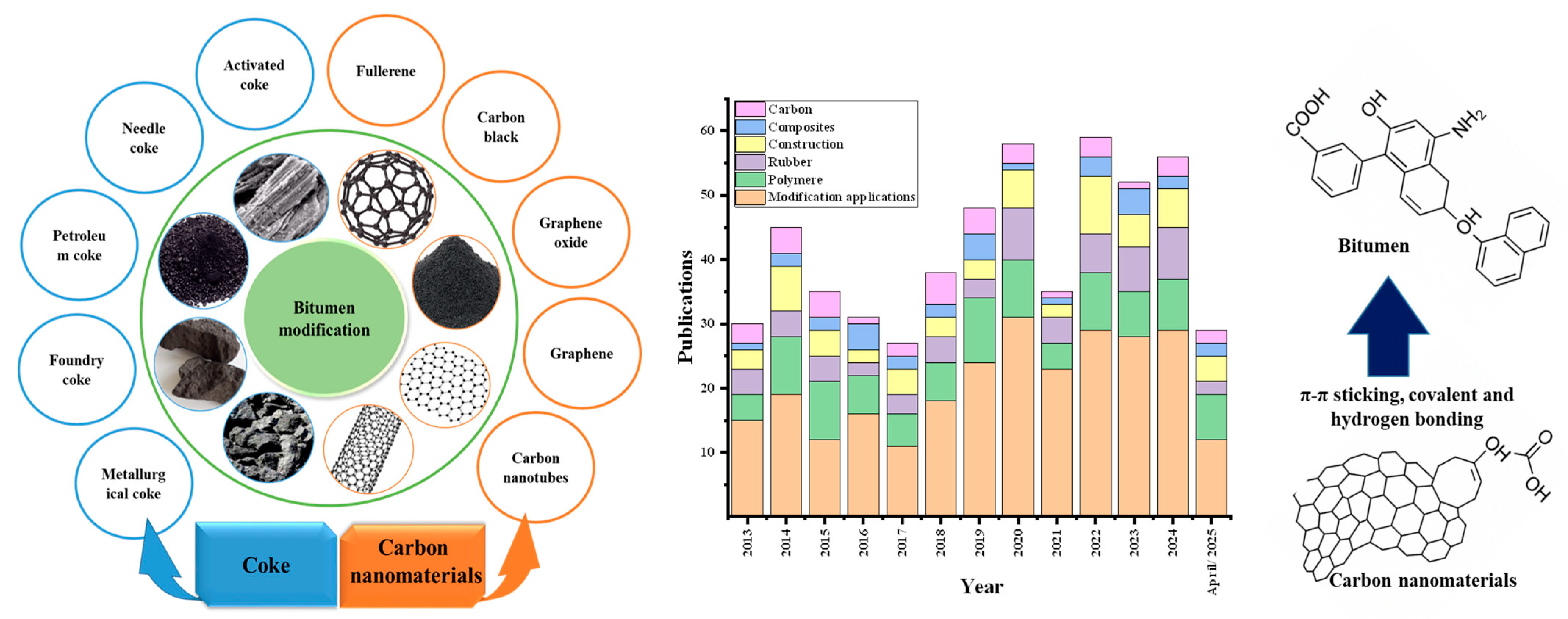
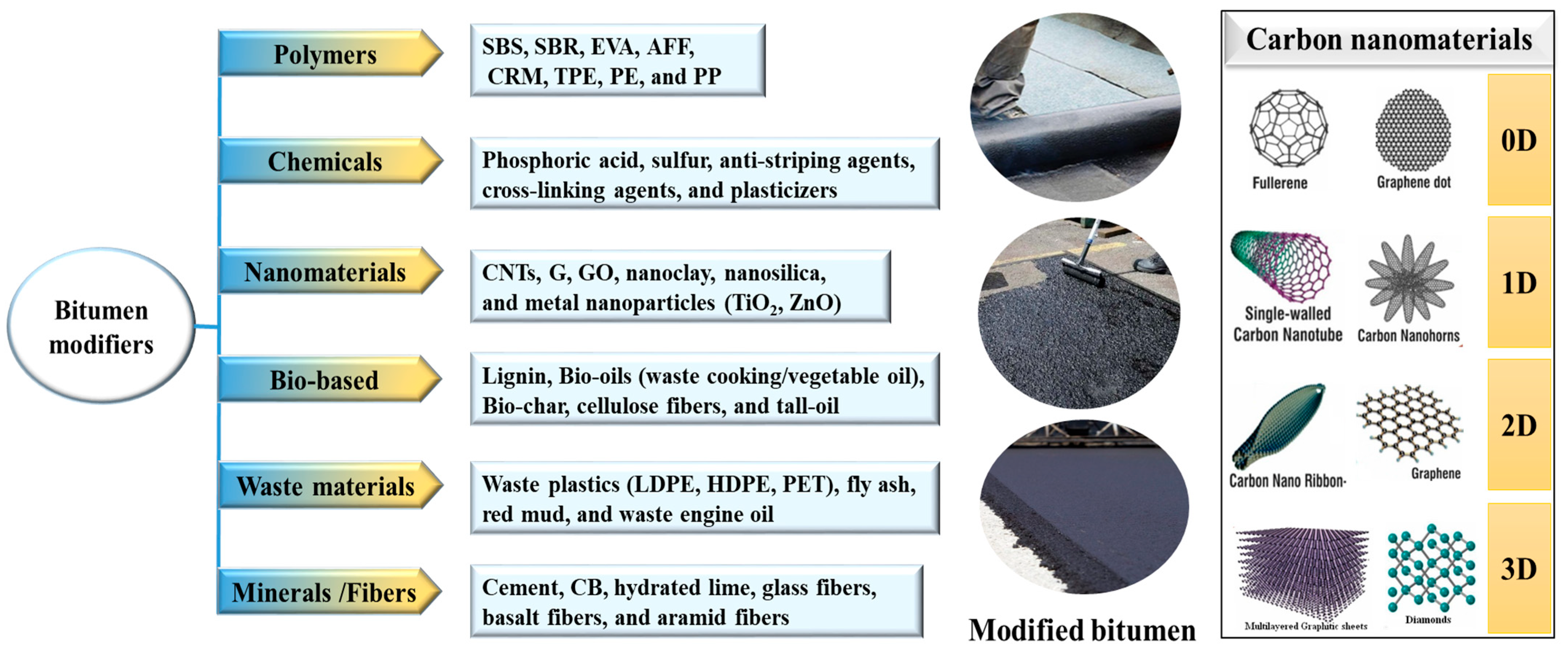
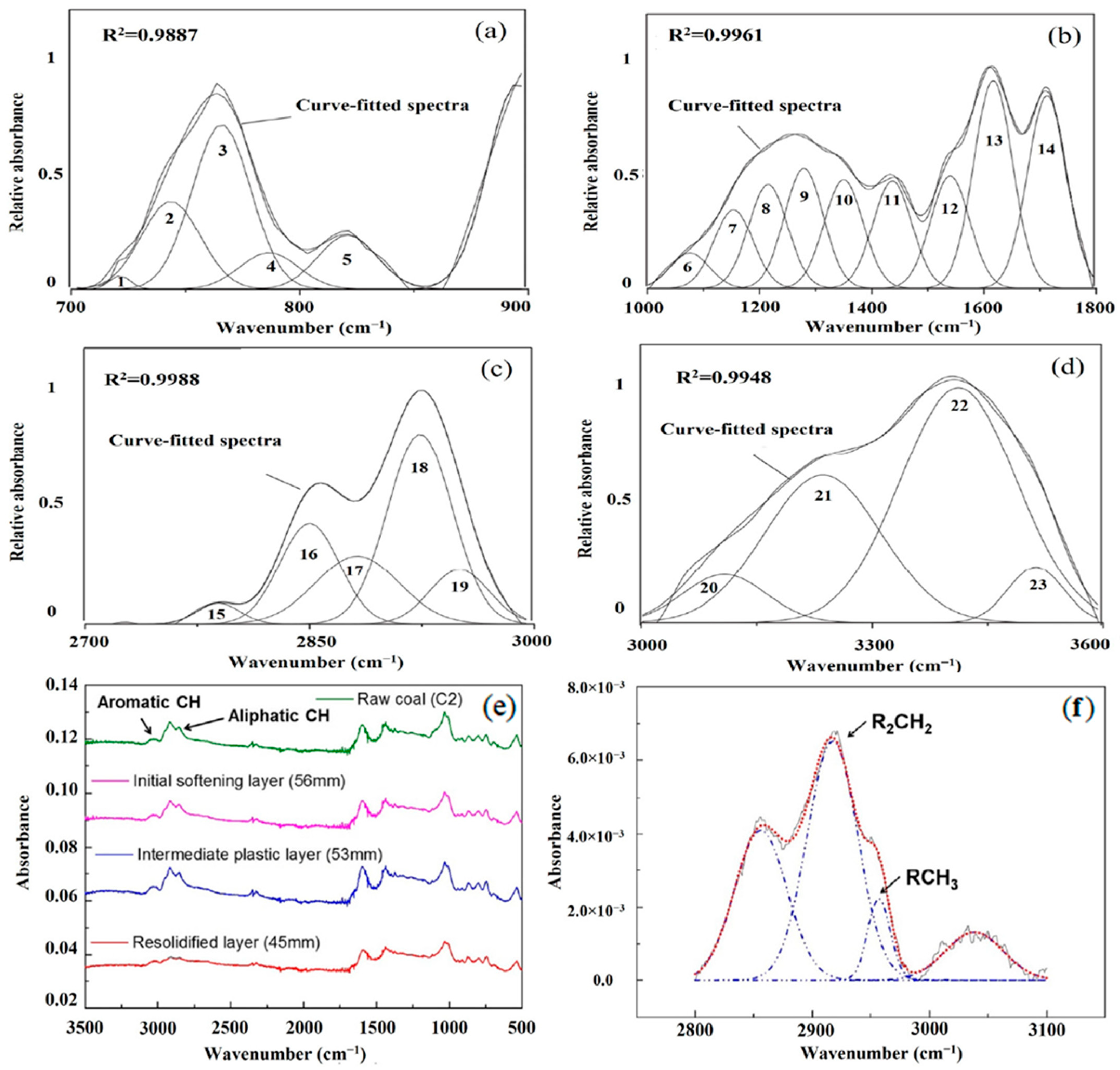
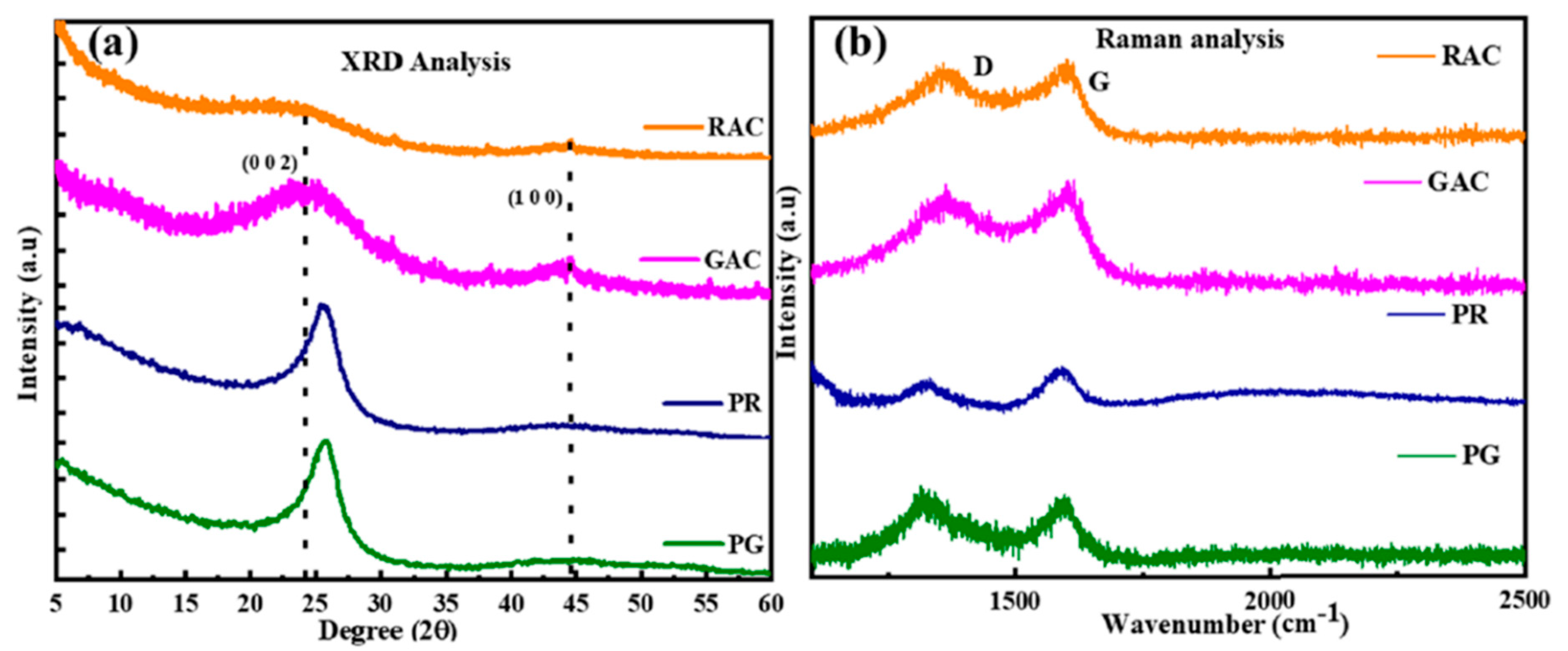
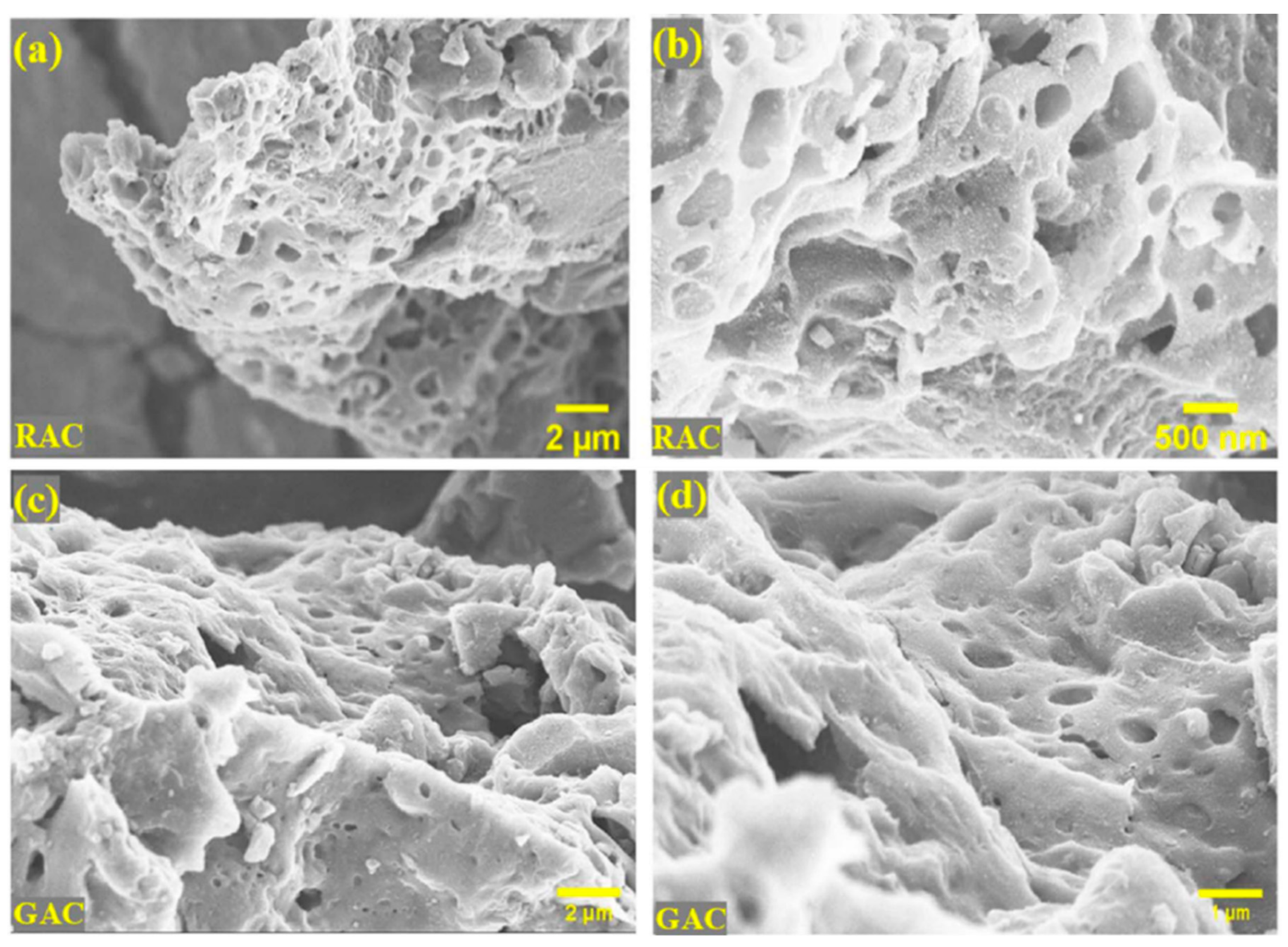
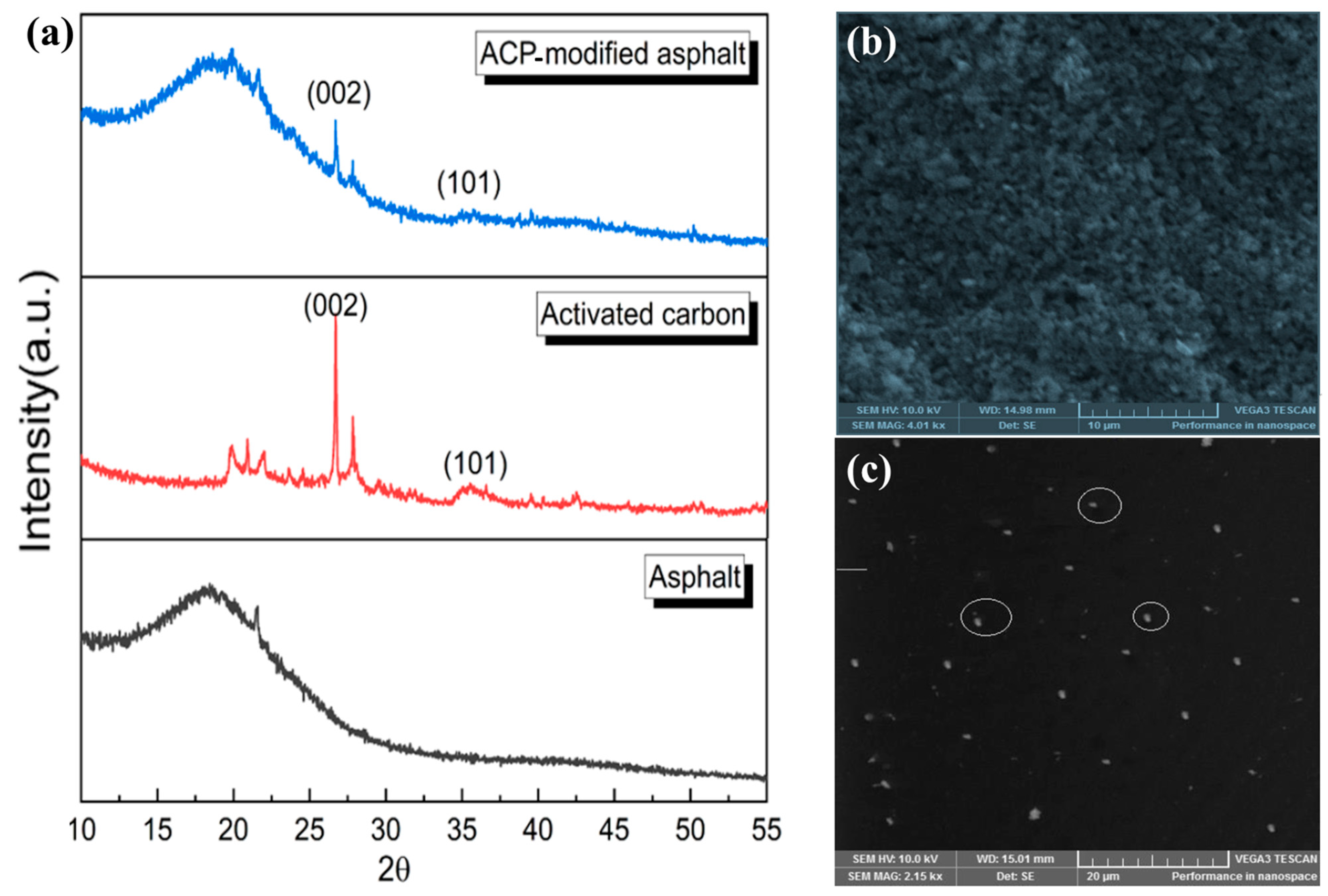
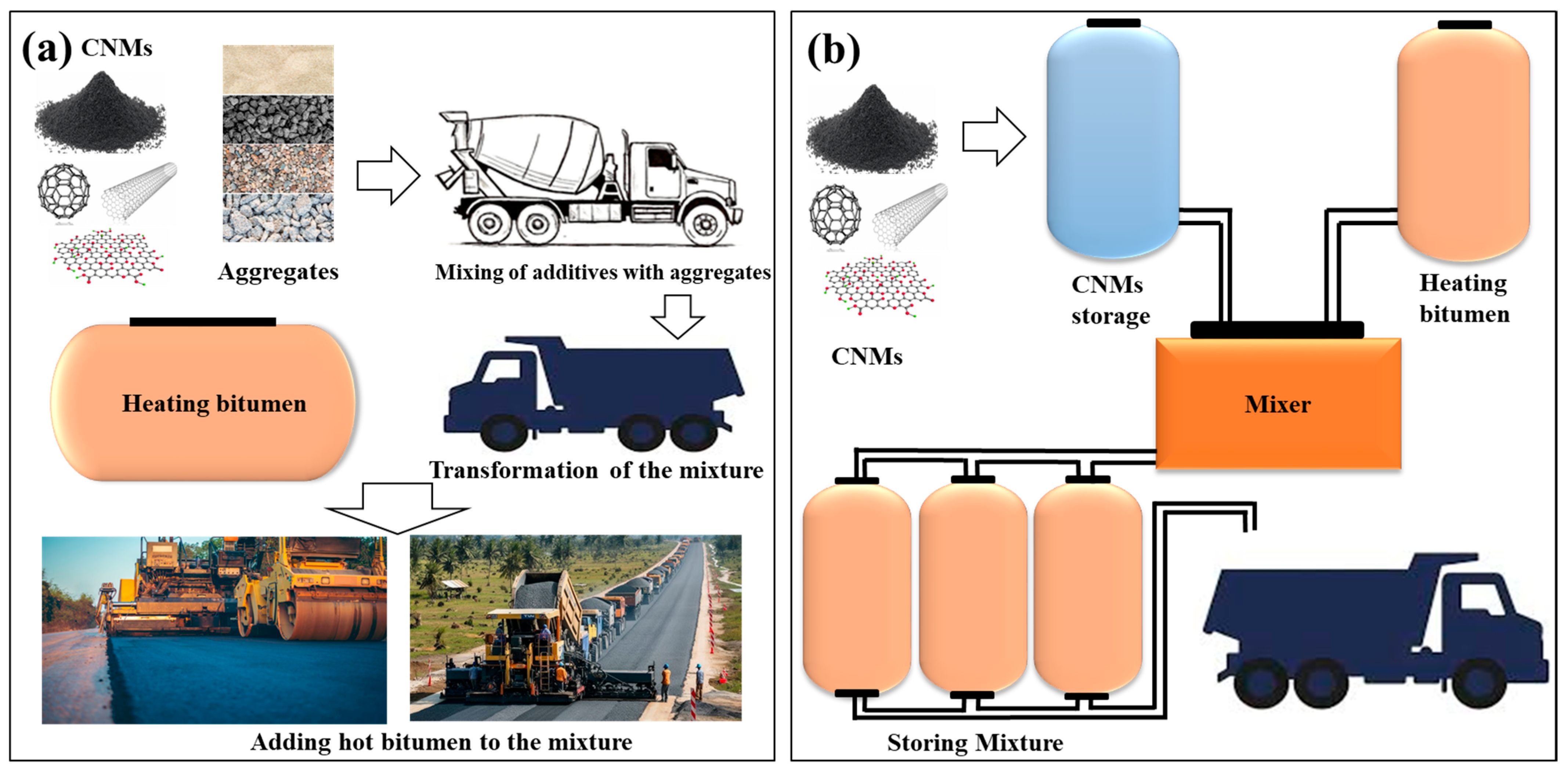
| No | Base Matrix and Modifier | Modifier (%wt) | Viscosity (Pa·s) | Softening Point (°C) | Rutting Resistance (kPa) | Test Conducted | ASTM Standards (Assumed) | Reference |
|---|---|---|---|---|---|---|---|---|
| 1 | C320 bitumen with SBS polymer | 7 | At 135 °C, from 0.45 to 0.33 | Increased from 48 to 55.2 | Increased to 1.32 (27%) | Penetration, softening point, viscosity, stiffness, FTIR, and fluorescence microscopy | D4402, D36, and D7175 | [19] |
| 2 | 80/100 bitumen with NR | 3–15 | Increased viscosity | Increased from 42 to 55 | 1.0 to 2.2 | Penetration, softening point, and ductility | D36 (softening point) | [18] |
| 3 | 60/70 bitumen with NC from coconut shell ash | 1.5–7.5 | Increased viscosity | Increased from 48 to 56 (12%) | 1.1 to 2.5 | Penetration, softening point, viscosity, ductility, Dynamic Shear Rheometer (DSR), and Rolling Thin-Film Oven (RTFO) | D4402 and D36 | [20] |
| 4 | Petroleum coke-modified bitumen | 5–10 | Increased viscosity | 52 to 58 | Penetration Index (0.1 mm) Form 38–55 | D36 and D5 | [21,22] | |
| 5 | Metallurgical coke-modified bitumen | 3 | Increased viscosity | 48 | Penetration Index (0.1 mm) 97.9 → 110 | D36 and D5 | [21,22] | |
| 6 | Epoxy resin with CNTs | 1.7 | This study focused on the mechanical properties of the epoxy resin, achieving a tensile modulus of 5.8 GPa and a flexural modulus of 6.0 GPa | Tensile and flexural properties and electrical and thermal conductivity | D638, D790, D257, and E1952 | [23] | ||
| 7 | PG 67-22 asphalt with GO | 2 | The study noted a 39% reduction in creep compliance (J_nr) and a 297% increase in percent recovery (εR), indicating enhanced rutting resistance | Rotational Viscosity (RV), Dynamic Shear Rheometer (DSR), Multiple Stress Creep and Recovery (MSCR), and aging property measurements | [24] | |||
| No | Type of Coke | Source | Major Properties | Application Area | Reference |
|---|---|---|---|---|---|
| 1 | Metallurgical coke | Coking coal blends | High porosity (40–50%), compressive strength (20–40 MPa), and low ash (<10%) | Blast furnace ironmaking and construction-grade concrete additives | [25] |
| 2 | Foundry coke | Coking coal | Larger size, high mechanical strength, and high carbon content | Metal melting in foundries and wear-resistant material fabrication | [26] |
| 3 | Petroleum coke | Oil refinery residues | Low ash, high sulfur (up to 6%), and dense structure | Anode production and carbon composites in construction | |
| 4 | Needle coke | Aromatic heavy oils | Highly crystalline with low thermal expansion | Graphite electrodes and carbon fiber reinforcements in mechanical parts | |
| 5 | Activated coke | Coal and biomass | High surface area (>500 m2/g) and microporous structure | Flue gas treatment and reinforced fillers in construction materials | [27] |
| 6 | Biomass-derived coke | Biomass (e.g., pyrolysis oil) | Tunable structure and renewable origin | Metallurgical coke substitute and eco-friendly construction composites | [28] |
| No. | Synthesis Method | Raw Materials | Properties | Process Temperature, °C | Application Area | Reference |
|---|---|---|---|---|---|---|
| 1 | High-temperature carbonization | Coking coal blends | High mechanical strength and porosity | 1000–1100 | Metallurgy and concrete additives for construction | [25] |
| 2 | Delayed coking | Petroleum residues | Low ash and high sulfur | 480–500 | Electrodes and carbon composites for mechanical structures | [26] |
| 3 | Needle coke production | Aromatic feedstocks | Highly crystalline and low expansion | Up to 1400 | High-strength graphite electrodes and carbon fiber for mechanical components | |
| 4 | Biomass pyrolysis | Biomass materials | Renewable and tunable pore structure | ~400–600 | Eco-friendly coke for metallurgy and green construction composites | [28] |
| 5 | Coke deposition on activation | Carbonaceous materials | Narrow pore size distribution | 800–1000 | Carbon molecular sieves and porous fillers for construction | [31] |
| 6 | Activated coke preparation | Coal and biomass | High surface area and adsorption ability | 700–900 | Flue gas pollutant removal and structural fillers for mechanical applications | [27] |
| No | Property | Description | Effect on Bitumen Interaction | Reference |
|---|---|---|---|---|
| 1 | Surface roughness and porosity | Irregular, porous structure with micro-cracks and cavities | Enhances mechanical interlocking and physical anchoring | [53,54] |
| 2 | Surface functional groups | Contains oxygenated groups (–OH, –COOH, –C=O) on surface | Promotes hydrogen bonding and dipole interactions with polar bitumen fractions | [55,56] |
| 3 | Hydrophobicity/wettability | Naturally hydrophobic unless oxidized | Influences bitumen spreading and wetting; low wettability reduces interfacial adhesion | [54] |
| 4 | Specific surface area (SSA) | High SSA in fine coke powders | Increases contact points for adsorption and interaction with bitumen molecules | [57,58] |
| 5 | Thermal stability | Remains stable at bitumen mixing temperatures (140–180 °C) | Allows sustained interfacial bonding during mixing and compaction | [53] |
| 6 | Resistance to moisture-induced damage | Low water affinity in unmodified coke | Reduces risk of stripping and debonding under wet or freeze–thaw conditions | [55,59] |
| 7 | Co-adsorption behavior | Tends to adsorb to bitumen’s asphaltenes and resins | Enhances binder homogeneity and emulsion stability | [58] |
| 8 | Particle size distribution | Variable, dependent on grinding or processing methods | Affects dispersion in bitumen and interface area available for bonding | [54] |
| No | Property | Conventional Bitumen | CNT-Modified Bitumen (0.5–2%wt) | Graphene-Modified Bitumen (1–2%wt) | Carbon Black-Modified Bitumen (5–10%wt) | Fullerene-Modified Bitumen (0.5–1%wt) | Reference |
|---|---|---|---|---|---|---|---|
| 1 | Softening point (°C) | 46–52 | 55–60 (+9–14 °C) | 55–63 (+9–17 °C) | 50–57 (+4–11 °C) | 48–56 (+2–10 °C) | [89,104] |
| 2 | Rutting resistance (% improvement) | – | 20–35% | 25–40% | 15–30% | 10–20% | [89,106] |
| 3 | Fatigue life (% improvement) | – | 15–30% | 20–35% | 10–20% | 5–15% | |
| 4 | Oxidative aging resistance (% reduction in aging rate) | – | 20–30% | 25–35% | 15–25% | 10–20% | [90,104] |
| 5 | Tensile strength (MPa) | 0.8–1.2 | 1.1–1.5 (+20–30%) | 1.2–1.6 (+25–35%) | 1.0–1.3 (+15–25%) | 0.9–1.3 (+10–20%) | [89,106] |
| 6 | Moisture damage resistance (% improvement) | – | 15–25% | 20–30% | 10–20% | 5–15% | [64,104] |
Disclaimer/Publisher’s Note: The statements, opinions and data contained in all publications are solely those of the individual author(s) and contributor(s) and not of MDPI and/or the editor(s). MDPI and/or the editor(s) disclaim responsibility for any injury to people or property resulting from any ideas, methods, instructions or products referred to in the content. |
© 2025 by the authors. Licensee MDPI, Basel, Switzerland. This article is an open access article distributed under the terms and conditions of the Creative Commons Attribution (CC BY) license (https://creativecommons.org/licenses/by/4.0/).
Share and Cite
Hashami, M.; Ongarbayev, Y.; Tileuberdi, Y.; Imanbayev, Y.; Zhambolova, A.; Kenzhegaliyeva, A.; Mansurov, Z. Integration of Coke and CNMs with Bitumen: Synthesis, Methods, and Characterization. Nanomaterials 2025, 15, 842. https://doi.org/10.3390/nano15110842
Hashami M, Ongarbayev Y, Tileuberdi Y, Imanbayev Y, Zhambolova A, Kenzhegaliyeva A, Mansurov Z. Integration of Coke and CNMs with Bitumen: Synthesis, Methods, and Characterization. Nanomaterials. 2025; 15(11):842. https://doi.org/10.3390/nano15110842
Chicago/Turabian StyleHashami, Muhammad, Yerdos Ongarbayev, Yerbol Tileuberdi, Yerzhan Imanbayev, Ainur Zhambolova, Aliya Kenzhegaliyeva, and Zulkhair Mansurov. 2025. "Integration of Coke and CNMs with Bitumen: Synthesis, Methods, and Characterization" Nanomaterials 15, no. 11: 842. https://doi.org/10.3390/nano15110842
APA StyleHashami, M., Ongarbayev, Y., Tileuberdi, Y., Imanbayev, Y., Zhambolova, A., Kenzhegaliyeva, A., & Mansurov, Z. (2025). Integration of Coke and CNMs with Bitumen: Synthesis, Methods, and Characterization. Nanomaterials, 15(11), 842. https://doi.org/10.3390/nano15110842







